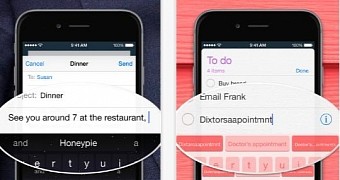Microsoft has just updated SwiftKey for iOS with a bunch of new features and more free times, with Android very likely to get them in the coming weeks.
Specifically, SwiftKey, which is currently one of the best third-party keyboard apps on iOS and Android, now features an emoji prediction panel that shows up when tapping on the regular emoji key.
This window displays a selection of 18 emoji that match your words, and given the advanced prediction engine integrated into SwiftKey, there’s a good chance that the one you’re looking for is also included.
Microsoft has also refined 3D Touch support, with the cursor control now more responsive. Microsoft says this was a top feature request from users who installed SwiftKey on iPhones with 3D Touch.
Haptic feedback, but not exactly what you expect
Additionally, the new update also introduces haptic feedback for iPhone 7, but you won’t get to feel the vibration when pressing on every key, but only when activating certain keyboard actions like opening the emoji panel. Haptic feedback for the full keyboard is still a dream that’s yet to come true for iPhone users, while Android phones have had this for years, so hopefully SwiftKey developers have this in mind for future updates.
SwiftKey also supports new languages starting with this version, such as Bambara, Ewe, Lingala, Mossi, and Wolof. We don’t really know how many people still use these languages in real life, let alone in SwiftKey, but it’s probably good to have them in Microsoft’s keyboard app.
And last but not least, there are 8 new Oxygen themes that you can install free of charge, with supported colors including red, orange, yellow, green, blue and pink.
The update is available in the App Store right now, though on our devices the aforementioned changes are yet to show up.
SwiftKey continues to be available on Android and iOS only, and while Windows 10 Mobile users are still drooling about all these updates, there’s no confirmation of a plan to bring it to Microsoft’s own smartphone platform, despite the fact that it owns the app.

 14 DAY TRIAL //
14 DAY TRIAL //